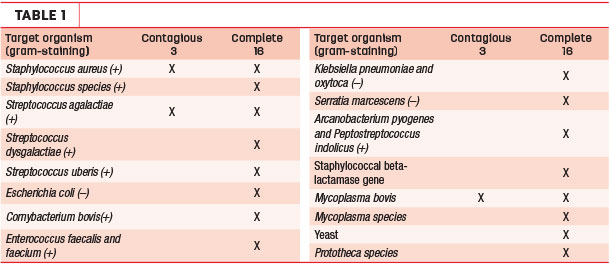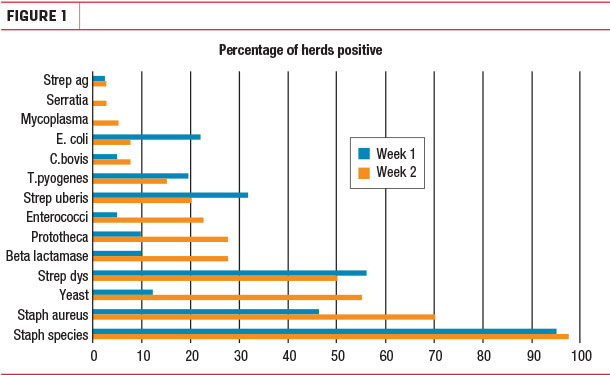We are all familiar with the phrase “time is money,” and this is never so true as when fighting contagious mastitis in dairy herds. One of the most frustrating challenges a dairy farmer faces is the inability to identify what is causing the problem; you send off a sample for culture, wait over a week and then get back a report stating “No Growth.”
According to Roger Buse, a Prairie Farms field rep with over 30 years’ experience, this past summer provided the toughest SCC challenge he has ever seen. “It hit hard; some farms took a tremendous financial loss.
They treated and treated, dumped milk, cultured samples – and still they got nowhere positive with the problem cows.” Producers were frustrated and looking for answers.
After reading about mastitis PCR testing in NorthStar Cooperative’s newsletter, Indiana dairy producer David Graber became intrigued about what kind of tool it offered to monitor mastitis in his herd and called to learn more about the process.
Initially, five producers sent samples to be analyzed and were so impressed with the speed and accuracy of the results, they encouraged others to do the same.
When Todd Byrem, Ph.D., director of AntelBio Systems; and Will Raphael, BVSc, Ph.D., research scientist at NorthStar Cooperative Inc. were presented the opportunity to work with 41 producers to conduct a research trial to help determine the usefulness of mastitis PCR as a surveillance tool, they did not hesitate to offer their time and assistance for this diagnostic event.
Two PCR test options are available: Contagious 3, which detects contagious organisms Mycoplasma bovis, Streptococcus agalactiae and Staphylococcus aureus; and Complete 16 PCR, which contains the Contagious 3 and detects the majority of environmental and contagious organisms (Table 1).
 PCR (polymerase chain reaction) detects the genetic material (DNA) unique to the mastitis-causing organism. DNA testing for mastitis works in ways culture cannot by detecting a variety of organisms, including the ones who are dead or dying; thus, the frustrating result “No Growth” is much less likely than with traditional culture testing.
PCR (polymerase chain reaction) detects the genetic material (DNA) unique to the mastitis-causing organism. DNA testing for mastitis works in ways culture cannot by detecting a variety of organisms, including the ones who are dead or dying; thus, the frustrating result “No Growth” is much less likely than with traditional culture testing.
PCR is accurate, quick and flexible. Results can be obtained in as little as 24 hours from milk that is fresh, frozen, treated, untreated or collected through DHIA. PCR’s extreme sensitivity and rapid turnaround – up to 10 days sooner than traditional culturing – allows fast, effective decision-making when working toward improving udder health and combating contagious mastitis.
For this trial, the Complete 16 PCR was utilized on bulk tank samples. Questions presented were, “Can we use PCR as a surveillance tool, and is it consistent?”
Samples from 41 herds were collected on Dec. 2 and again on Dec. 9. During a meeting held in Montgomery, Indiana, on Dec. 13, Byrem discussed the data from the Complete 16 PCR assay and stated, “Everyone now has a baseline, so when SCC spikes, PCR can determine what is going on or different in the herd.
An assay that has consistency will allow producers to identify abnormal findings and allow them to trigger protocols to get pathogens back under control.”
Both Byrem and Raphael stressed that equipment maintenance, compromised teat ends, environmental factors, milking procedures and milking order all have a great effect on mastitis. Control the controllables and develop a baseline to monitor for new challenges.
When asked about follow-up with producers on the research trial, Raphael stated, “Todd and I are quite comfortable to take 41 phone calls and interpret your results.”
During the meeting, Raphael commented on the frustrating problems associated with traditional culturing of samples and then challenged the group by saying, “Many times you send the sample to the lab and it shows no growth; why would you use antibiotics when the organism is already dead? It is a waste of resources.”
Furthermore, he went on to advise the crowd, “The most beneficial role of intramammary antibiotics in subclinical mastitis is at dry-off. Use the culture lab to identify gram-positive or gram-negative or no growth. The role for intramammary antibiotics for gram-negative infections is really, really minimal; it all comes down to prevention, and keeping the cows pristine has a lasting impact.”
Drawing attention to the summarized results, Raphael stated, “Many of you, upward of 40 percent of you, have the same problems – staph species and Staph aureus (Figure 1). Many cows infected with Staph aureus will be difficult or impossible to cure. You need to know which cows have this in order to make an economic decision.”

He suggested utilizing DHIA records to determine the highest-SCC cows and then doing individual-cow PCR tests.
If DHIA is unavailable, identify infected cows using the California Mastitis Test. Raphael said, “The magic rule of mastitis is that many mastitis risk factors are possible across 41 management styles, so it is important to use people like your local veterinarian to identify your problem areas."
"It is dangerous to interpret one test, but testing regularly gives confidence in results from one week to the next. If we repeat these bulk tank tests again, we will really be set with a baseline profile of subclinical mastitis organisms before the environmental challenges of spring.”
It is important to understand there are limitations to PCR testing. Clouded interpretations may result if milk lines or other equipment are not sanitary. PCR must be interpreted alongside standard cooperative results.
To develop a baseline and identify what mastitis organisms are in your herd, a bulk tank sample or group sample is convenient and economical. You can send samples directly to the lab.
For individual samples, save time and labor by using DHIA samples for Contagious 3 or Complete 16 tests. There is also a pooling option available to cut testing costs. By working with DHIA records, the top-SCC cows are quickly identified, their samples pooled, then individual problem cows can be identified.
Results are available within 24 hours of receipt at the lab and can be accessed online, through email or text. Call your local DHIA or go online (North Star Cooperative Mastitis-PCR) to learn what PCR testing can do for your herd. ![]()
Somula Schwoeppe is a dairy producer and freelance writer from Huntingburg, Indiana







